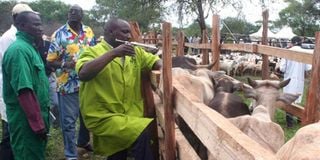Decade since rinderpest was eradicated, we must still be on guard

A veterinary officer vaccinates cattle at Kinna livestock market in Garbatulla during a livestock vaccination exercise to mark the eradication of rinderpest.
In 2011, the globe assembled to celebrate the eradication of rinderpest. This made it the first ever animal disease to be declared eradicated. It came second after human smallpox, which had been eradicated in 1980.
These two great milestones gave the world lessons that are being applied to several diseases destined for eradication. Today, June 28, the world marks 10 years since we achieved this great success.
Rinderpest was a deadly viral disease that attacked livestock and wild animals, wreaking havoc in farming communities and the general public the world over.
Rinderpest outbreaks instigated famines and even civil unrest. The disease mainly affected cattle, buffalo, eland, kudu and warthog, among other wild animals.
Massive deaths of animals from rinderpest in France inspired the establishment of the first veterinary school in Lyon in 1762. The industrial revolution that followed served to fan the spread of the disease due to increased transportation of live animals across Europe and other parts of the world.
The very first international animal health conferences were held to discuss ways of fighting rinderpest. The World Organization for Animal Health (OIE), as we know it today, was formed in 1924 as an intergovernmental effort to combat rinderpest.
Africa was not left behind, as the disease spread into its naïve herds of domestic and wild animals, killing them in their millions. The continent joined the rest of the globe in the fight to vanquish rinderpest following the discovery of an effective vaccine against this deadly disease.
The Pan-African Rinderpest Campaign (PARC), followed by the programme for the Pan-African Control of Epizootics (PACE), supported continent-wide mass vaccinations and surveillance. These efforts yielded fruits and in the 1990s most countries were declared provisionally free from rinderpest.
Kenya played a pivotal role in the fight to eradicate rinderpest. It hosted the African Union Inter-African Bureau for Animal Resources, a specialised arm of the African Union that coordinated the livestock vaccinations and surveillance of rinderpest. It was also in Kenya that Walter Plowright developed a safer rinderpest vaccine in 1957.
The eradication of rinderpest was a great relief to millions of livestock farmers who had suffered losses for years. This freedom from the disease is thus a gem that we must all work to maintain.
The lessons learned from this battle have informed many other disease eradication campaigns globally. It showed that vaccines work and are a lethal arm against diseases when deployed in a well-coordinated manner.
The freedom-from-rinderpest status does not mean that the disease cannot re-emerge. It is for this reason that immediately after the disease was eradicated, measures were put in place to maintain the status.
The Food and Agriculture Organization (FAO) and the OIE have been working with many countries around the world to maintain this status. In the unfortunate event that the disease re-emerges, interventions are put in place to quickly restore the freedom status.
Kenya has collaborated in this effort by continued sensitisation of its field veterinary and laboratory staff and the general public about rinderpest inasmuch as it is eradicated. This is to avoid any negative perception that nothing needs to be done as the disease has been eradicated.
The clarion call has been that even though rinderpest was eradicated, it should not be forgotten. The main risk has been the presence of rinderpest-containing materials still kept by some countries in their labs in the form of rinderpest vaccines, animal samples or remnants of infected animal tissues.
FAO and OIE are advocating for the destruction or safe storage of these materials in labs that have been approved to have the capacity to safely store such materials. This will minimise intentional or unintentional release of such materials into the environment.
Kenya already destroyed all its materials containing the rinderpest virus. It has also done a table-top simulation to gauge its preparedness to tackle an outbreak.
Riding on the successful eradication of rinderpest, Kenya is working to eradicate other livestock diseases, such as rabies and peste des petit ruminants (PPR), while carrying out vaccinations against a number of livestock diseases as a disease-control strategy.
Today, Kenya joins the rest of the world in celebrating the 10th anniversary of the eradication of rinderpest. We commit to be part of that team working to maintain the freedom from rinderpest.
Dr Njagi is director of veterinary services and the Kenya delegate to the World Organization for Animal Health (OIE)




